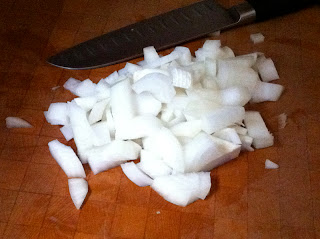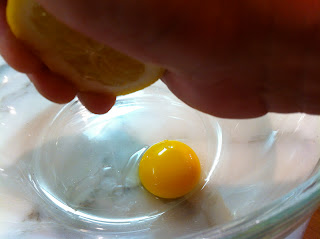I've always loved soups and stews. As long as I can remember I have had a soft spot of sorts for the stuff. Hot, cold, room temp at times. Made of vegetables, meats and a few cold fruit soups come to mind.
Not just any soup mind you, it has to be well constructed with balanced seasoning, textures and flavors. There is a ton of soup out there that is nearly inedible, you know the type, over seasoned, confused or just plain wrong.
The good ones stick with you, as do the bad.
The best that I can think of that rush into mind when I think of what a soup or stew should be: the parsley soup with escargot and a "leaf" of peeled tomato from La Folie in San Francisco, the cream of cauliflower from Amelio's (also in SF), a cold cherry soup from a restaurant whose name escapes me that my family went to in Phoenix when I was a child and a cold peach soup that was made in my home by our friend Juliette from France.
Those are the really good ones.
The worst soup that I have ever had, I am sad to say was served in a restaurant that I managed, that is until I was called on the phone by one of my servers to alert me of its' existence. It was a...sauerkraut and breakfast sausage soup with a watery milk broth that was overloaded with rosemary.
I don't know what the cook who made it was thinking but it was 86'd on the spot. Ugh! That soup was so far off the mark that it wasn't even worth trying to fix.
Today I will NOT be making that soup and I hope I never encounter anything like it again.
Today, as the weather starts to turn cold as summer slips away and autumn replaces it is a day for stew.
Here is my recipe for beef stew:
2 lbs beef stew meat
2 T all purpose flour
1 medium yellow onion
2 medium sized cloves of garlic
2 qts of chicken stock, beff stock or a combination of the two
2-3 medium carrots
1 large or two medium russet potatoes
Kosher salt
Black pepper
For the thickener, a classic roux:
1 T all purpose flour
1 T butter
Simple really. I think that I often appreciate the more simple recipes as the individual ingredients which while combining their flavors together create the whole experience, each flavor can remain distinct as well.
Let's start.
Place the stew meat onto your cutting board and remove any sinew that is present.
Cut the pieces into bite sized pieces.
Salt and pepper the beef.
Place the first measure of flour into a bowl, add the meat and coat it with the flour.
In a 3 qt pot add some oil, enough to coat the bottom, and turn the heat on high. When the oil looks more like water when you bump the pan, add the meat in small batches and sear it on all sides.
Do this in batches for best results removing the seared meat to a plate or bowl lined with paper towels to absorb any excess oil.
As you cook your batches you will likely have to add additional oil to the pot to sear the beef. You will notice that small amounts of the beef and some of the flour will stick to the bottom of your pan.
This is O.K., we will remove that later and your stew will be all the better for it!
As the meat is searing dice the onion into 1/4" - 1/2" pieces.
Once the beef is done, remove excess oils from the pan, reduce the heat to medium and add the onion. Stir frequently so that it doesn't burn and turn bitter.
Mince the garlic and add it to the onions once they are translucent.
Sauté until fragrant.
Return the meat to the pot and add your stock.
If you do not have stock available to you, use a low sodium commercially produced broth. Please do not use bullion cubes as they contain so much salt that you will have lost much of your ability to season your stew properly. Also, their flavor is hardly like the real thing!
Reduce the heat to just above a simmer. The liquid should bubble gently, avoid a rolling boil.
At this time, scrape the bottom of the pan with a wooden spoon to remove the meat and flour that is stuck to the bottom. This will add color and a really nice flavor to your stew.
Most stew meat is made from the toughest parts of the animal. These are usually from the most active muscles from the animal and have the most flavor but can be tough if cooked quickly.
These type of meat need to be cooked low and slow in liquid to break down the connective tissues so that they will be tender when you are done. The bottom line is that you are braising them on the stove, so be patient.
While your stew is simmering on the stove, peel the potatoes, cut them into bite sized pieces similar to your stew meat and store them in cool water.
Peel the carrots. Cut them lengthwise, cut into similar sized pieces and store for later.
Every 15 minutes or so, pull a pice of meat from the pot and give it a taste to se if it is tender.
Once the meat is tender add the carrots and simmer.
Place the butter (clarified if you have it, but not necessary. See this post for instructions: ) into a sauté pan. If you are not using whole butter instead of clarified butter, wait for it to melt and for the bubbles to subside.
Add the flour and stir with a wire whip until combined. Continue to cook until the flour begins to brown and has a slightly nutty smell.
Slowly add some of the stew liquid into the roux and incorporate it with the whip. Continue to add liquid until the roux is no longer firm but a slightly loose liquid.
Add the roux to the stew and stir.
Add the potatoes to the stew and season with salt and pepper until you have reached the flavor that you wish. Simmer until the potatoes are just tender.
Turn off the heat and hold for dinner.
This can be done a day ahead and is probably better made the day before to allow the flavors to reach their potential.
When the stew is re-heated for service, check the seasoning and adjust if necessary.

















































